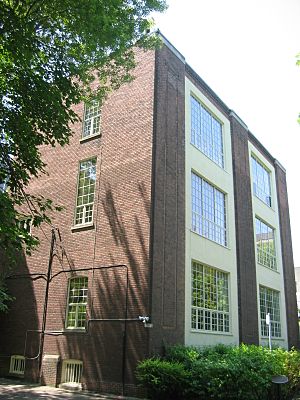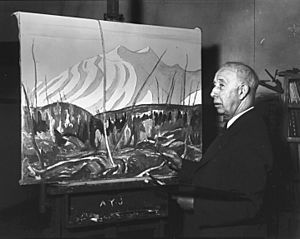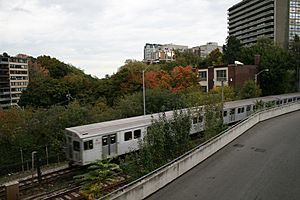Studio Building (Toronto) facts for kids
Quick facts for kids The Studio Building |
|
|---|---|
 |
|
| Location | 25 Severn Street Toronto, Ontario, Canada |
| Built | 1914 |
| Original use | Studios |
| Current use | Studios |
| Architect | Eden Smith |
| Designated | 2005 |
The Studio Building in Toronto, Ontario, Canada, is a very important place in Canadian art history. It was the home and workplace for many famous Canadian painters. These included members of the Group of Seven, and other artists who came before and after them.
The building was named a National Historic Site of Canada in 2005. This shows how important it is to the country's heritage. It is located at 25 Severn Street, in a quiet valley called the Rosedale ravine. This spot was chosen because it gets a soft, even light from the north, which is perfect for artists.
Contents
Building a Home for Canadian Art
The Studio Building was built to help Canadian artists. It was paid for by Lawren Harris, whose family owned the Massey-Harris farm machinery company, and Dr. James MacCallum. They wanted to create a place where artists could live, meet, and work together. Their goal was to help a unique Canadian art style grow, especially one that showed the country's amazing landscapes.
The building was designed by Arts and Crafts architect Eden Smith. Construction finished in January 1914. Harris and MacCallum made sure the rent was low, just $22 a month. This low rent only covered the building's costs, making it easy for artists to afford a studio.
Early Artists and the Group of Seven
Many famous artists lived and worked in the Studio Building. Tom Thomson was one of the first. He was a "starving artist," meaning he didn't have much money. Dr. MacCallum helped him financially so he could focus on his art full-time. Thomson first shared a studio with A.Y. Jackson.
Thomson loved the wilderness and found city studios "pretentious." He often spent summers in Algonquin Park as a ranger. In winter, he would come back to the Studio Building to turn his outdoor sketches into bigger paintings. Because he couldn't afford the rent, the other artists helped him. MacCallum paid to fix up a small shed on the building's east side. Thomson lived there for only $1 a month during his last winters.

After fighting in World War I, A.Y. Jackson returned to the Studio Building. He moved into Studio 6 on the top floor. He even used an easel that Tom Thomson had made. Soon after, Jackson learned he was part of a new group of artists called the Group of Seven. They had their first art show, and even though some people didn't like their art, the Group became famous. They were seen as leaders of a new, truly Canadian art style.
Changes Over Time
By 1940, Lawren Harris had moved away. In 1948, he sold the Studio Building for $20,000 to Gordon MacNamara, a lawyer who had become an artist.
The building was no longer as busy as it once was. A.Y. Jackson was the only original tenant and Group of Seven member still living there. He later wrote that MacNamara would complain about the noise he made while preparing his canvases. Jackson eventually left the building in 1955. Lawren Harris wrote to him, saying:
Your moving from the Studio Building marks the end of an era, the one era of creative art that has the greatest significance for Canada... You were the real force and inspiration that led all of us into a modern conception that suited this country, and the last to leave the home base of operations.
In 1962, art collector Robert McMichael bought Tom Thomson's old shed. He moved it to the McMichael gallery in Kleinberg, where it is now on display. MacNamara was careful about selling the shed because people knew it was historically important.
Later, Gordon MacNamara faced a challenge when new tall buildings were planned near the Studio Building. These buildings could block the special light that artists had enjoyed for many years. MacNamara fought against these plans to protect the building's light. He also worked to get the Studio Building recognized as a National Historic Site, which he achieved.
Gordon MacNamara passed away in 2006. His son has thought about selling the building, which is valued at $1.37 million. Even though its historic status mainly protects the outside of the building, many people hope that a new owner will continue to protect its important legacy as a Canadian art treasure.
Images for kids



